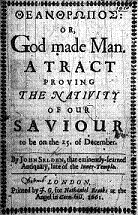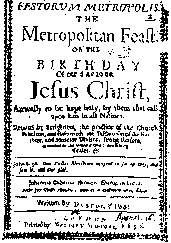The Babylonian Calendar
after R.A. Parker & W.H. Dubberstein,
Babylonian Chronology
[Providence, Rhode Island, 1956]
Adapted from an article by Kelley L. Ross, Ph.D
http://www.friesian.com/calendar.htm
The Luni-Solar Calendar
The beginning of the month in the Babylonian calendar was determined by the direct observation by priests of the young crescent moon at sunset after the astronomical New Moon. This custom is remembered in Judaism and Islâm with the principle that the new calendar day begins at sunset. In Islâm, months whose commencement is of religious significance, like the month after the Fast of Ramadân, still depend on the actual observation of the crescent moon by a respected religious authority.
|
If weather prevented the observation of the
crescent, the Babylonians would begin the new month anyway after 30
days. In the Jewish and Islâmic calendars, each month is given a
conventional length, alternating 30 days and 29 days. For
convenience, the table at left applies that device for the
Babylonian months, which will enable us to construct a working model
of the Babylonian calendar without the priests of Marduk. With the actual observation of the crescent by the Babylonians, eventually a pattern emerged, and this began to suggest a ycle. This was the 19 Year Cycle, discussed below. The cycle settled down into its classic form in the 19 year period beginning in 424 BC [R.A. Parker & W.H. Dubberstein, Babylonian Chronology, Providence, R.I., 1956]. |
|||||||||||||||||||||||||||||||||||||||||||||||||
A fairly complete record of intercalations is available from about 623. The distribution of intercalary months is evident from about 500, while the 424 cycle is noteworthy in that a second Ululu becomes standard in the 17th year. As it happens, the 17th year is the one in which Nisannu occurs the earliest.
The Babylonian New Year was, astronomically, the first New Moon (actually the first visible crescent) after the Vernal Equinox. Modern dates on the Gregorian calendar for the Babylonian New Year may be chosen from the following table. In this table, the "uncorrected" dates use the 19 year lunar cycle, just as it was established in the 5th century BC, continued straight down to the present. The earliest New Year is marked with "<" and the latest with ">." Note that in the "uncorrected early" column the earliest date is only 3/31 and the latest is all the way to 4/28. The 19 year cycle adjusts lunar months to the solar year; but if the Babylonian New Year was supposed to be the first New Moon after the Vernal Equinox, then the system has been running slow and the cycle is much in need of correction. There are no priests of Marduk any more to do that. The correction, however, can be accomplished simply by delaying every single intercalation a whole year. Hence the "corrected" columns, where earliest and latest dates are 3/20 & 4/17 (or 3/21 & 4/18).
|
"Early" and "late" refer to the best day to see the new crescent (meaning the previous evening of the calendar date, however, since by Babylonian reckoning, as with the Jewish and Moslem calendars today, the day begins at sunset). This is the other problem that such a calendar must deal with, to adjust the length of the lunar month to whole days. This was not even attempted by the Babylonians, so the table just provides a range (early vs. late), that we can compare with other lunar and luni-solar calendars. On the Moslem calendar the first day of the month is usually the second day after the astronomical New Moon (so that the crescent can be observed). The "late" columns fit that pretty well. On the Jewish calendar, the first day of the month can be the New Moon itself, or it can be delayed as much as on the Moslem calendar. In 1992, for instance, both the Jewish and the Moslem months (Niisân & Shawwaal) corresponding to the Babylonian New Year happen to begin on 4/4, only a day after the astronomical New Moon, so the "early" date would be preferable for the 1992 Babylonian New Year, lest 1 Nisannu be lonely on 4/5.
The "AN" years are the Era of Nabonassar, Anno Nabonassari, dating from the reign of the Babylonian King Nabûnâs.iru in 747 BC. Any AN year can be obtained simply by adding 747 to the year of the AD era. Note that 747 BC is equivalent to -746 AD (1 BC=0 AD). The appropriate Seleucid year (Anno Seleucidarum), named after Seleucus I, one of Alexander the Great's generals, who obtained the eastern part of Alexander's Empire, can be calculated by adding 311 to the AD era -- e.g. 1992 AD = 2739 AN = 2303 Anno Seleucidarum -- but the Greek reckoning of 2303 begins the previous fall. The Era of Nabonassar works excellently for the Babylonian calendar, since dividing any AN year by 19 gives the year of the 19 year cycle as the remainder; e.g. 2739/19 = 144 rem 3. Although the 19 year cycle was not regularized until the 4th century, the astronomical records handed down from the Babylonian Priests Kidunnu and Berossos through the Greco-Roman astronomer Claudius Ptolemy begin with Nabonassar. It was Ptolemy who thus formulated the Era of Nabonassar for his astronomical reckoning. The Era was never used by the Babylonians themselves.
A further complication was that the Era of Nabonassar was only used by Ptolemy in conjunction with the Egyptian calendar, which had a year that was exactly 365 days long (no leap years) and so ran fast: That "Era of Nabonassar" was already up to 2741 in 1992. The Seleucid Era was used with the Babylonian calendar, but division by 19 inconveniently does not work with it. The Era of Nabonassar doesn't cover much of Mesopotamian history, but it does cover the history of the calendar that we know about; and Ptolemy's "Canon of Kings," a list of rulers from Nabonassar to the Roman Emperor Antoninus Pius, was absolutely fundamental for ancient chronology -- as recounted in E.J. Bickerman's Chronology of the Ancient World [Cornell, 1982].
The tables above are not constructed from astronomical data (except indirectly) but are schematically determined using a trick borrowed from the construction of the Gregorian Easter tables: the corresponding New Moon for the following year is determined simply by subtracting 11 from the given year's date; e.g. a 4/26 New Year one year means that the next year it will be 4/15. In an intercalary year (marked with "*"), 30 days are added; e.g. 4/4 -11 +30 = 4/23. This works out quite well, except that it comes out a day off after 19 years. The Gregorian Easter reckoning simply ignores that extra day. With the Babylonian calendar, something else is possible: once every 19 years a second month of Ululu is added as the intercalary month instead of a second Addaru. Originally that was in the 17th year (marked "§"). If Ululu II is added as 29 days instead of 30, that makes the whole cycle come out even, which is what is done in the table. Year 17 also happens to be the one with the earliest New Year, so we could adopt the rule that the year with the earliest New Year, which will always be an intercalary year, is also the one with an extra Ululu instead of an extra Addaru. Hopefully, the priests of Marduk would have approved. In the "corrected" calendar, the year with Ululu II turns out to be year 18 anyway, which isn't very different from the traditional year.
Using Gregorian dates as above, we end up off by a day against the moon about every 235 years. Thus, as time goes on, a day must occasionally be added to the given dates. Right now we happen to be in a bit of a cusp: the "late" tables above will become increasingly accurate and will remain so for a couple of centuries, longer than we now need to worry about. Or we can simply construct a complete modern system for the Babylonian calendar, as follows.
Adding 7 months every 19 years approximates the solar year with 235 lunar months. That is mathematically the most accurate convenient cycle for a luni-solar calendar and would give, using the mean value of the synodic month (29.530588 days), a year of 365.2467463 days long. This may be called the "Metonic" year, after the Greek astronomer who described the cycle, although the Babylonians discovered it first. The mean solar (tropical) year is 365.24219878 days long. The calendar thus has two problems: (1) This is more accurate than the Julian Calendar (365.25) but less accurate than the Gregorian (365.2425) and must in the long run make provision for correction -- it is off a day every 219 years against the sun. (2) The calendar cannot be corrected for the sun by subtracting a day every 219 years or so, because this would then put it out of synchronization with the moon. A luni-solar calendar must regulate its lunar side with days and its solar side by its addition of months. The solar side thus must be corrected by modifying the 19 year cycle, most conveniently by delaying an intercalation every 342 years (18 cycles). By such delays, the calendar would lose an entire month after 6498 years, which reduces the Metonic year to 365.2422018 days, accurate to a day in 336,700 years.
For the moon, days may be added just as days are added to the Julian, Gregorian, and Moslem calendars. The Julian pattern, a day every four years, is conveniently accurate, more accurate than in the Julian calendar itself: 365.25 days is off a day in 307 years against the Metonic year but off a day in only 128 years against the solar year [note that the Gregorian year, 365.2525, is less accurate against the Metonic year, off a day in 235 years]. A Gregorian-like correction on the Julian year may thus be imposed against the Metonic year: skipping a day every 300 years; 365 + 1/4 - 1/300 = 365.2466666. That approximates the Metonic year to within a day every 12,555 years. Quite accurate enough for the moon. With the 6498 year cycle of intercalations, 365 +1/4 - 1/300 - 29/6498, this produces a solar year of 365.2422038 days. That is not quite as accurate as the pure intercalation cycle: it is now off a day in 201,005 years. That is practically perfect, however; the orbits of the earth and the moon are liable to vary enough in that period of time, and the rotation of the earth to slow down enough, to render greater "accuracy" meaningless.
The Jewish Calendar
and the Era of Nabonassar
|
The Jewish calendar retains not only the
Babylonian Month names (e.g. Nisan for Nisannu) but also the
Babylonian 19 year cycle. The adoption of the cycle is evidently the
reform effected by the Patriarch Hillel II in the 4th century, but
the cycle as presently constituted dates from the 9th or 10th
centuries, when the complete calendar system was apparently
formulated. The 19 year cycle is the only true cycle in the Jewish
calendar, since the method of adding days depends on the mean value
of the synodic month and does not produce a repetition of dates
within any significant length of time. The dates of Rô'sh
Hashshânâh, however, roughly repeat after 247 years (13
cycles). Information about the origin of the modern Jewish calendar is not always historically accurate. It is often said that the calendar was formulated by Patriarch Hillel II in 358/359 AD. However, it appears likely that the calendar reform at this point was simply to introduce the Babylonian 19 year cycle, which meant that lunar intercalations did not need to be announced year by year. We can estimate the date for the present full mechanism of the calendar from the amount of error that has accumulated. The benchmark for the New Moon is now accurate for a meridian in Afghanistan. If we run things back to when it would have been accurate for a meridian through Jerusalem or Babylon, the centers of Jewish life and calendar studies, we just get back to around the 9th or 10th centuries. As it happens, we know that there were controversies about the calendar in that era. Saddiah Goan (882-942), who wrote works on the calendar, participated in a dispute about whether the Palestinian or Babylonian communities would rule on calendar issues. He represented the Babylonian community (which by then centered more in Baghdad, where recourse was sometimes needed to the Caliph, than in Babylon), which won the dispute. |
|
|||||||||||||||||||||||||||||||||||||||||||||||||||||||||
It seems beyond coincidence that was the period for which the new Moon benchmark would have been accurate. When the Môlâd Tishrii occurs on a Sunday, Wednesday, or Friday, Râ'sh Hashshânâh is postponed to the following day. This is done to prevent Yôm Kippûr from occurring on the day before or the day after the Shabbât or Hôshanâ Rabbâ from occurring on the Shabbât.
___________________________________

Adoration of the Shepherds
All rights reserved.
 John Seleden’s
John Seleden’s




